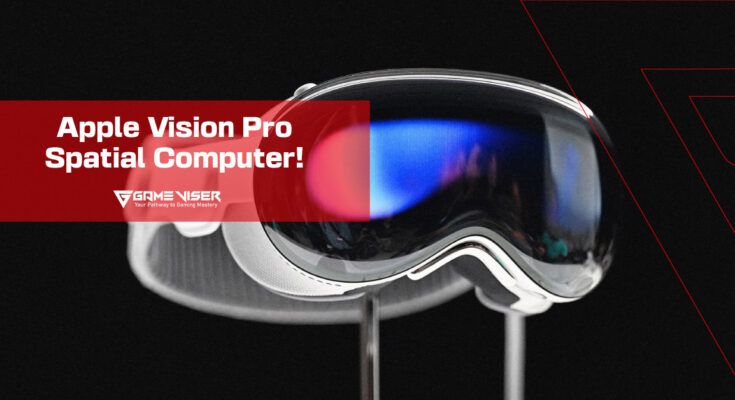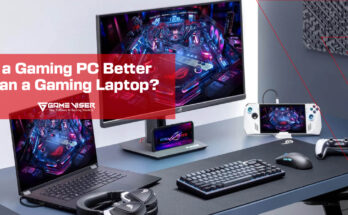Let’s explore the future of mixed reality with the Apple Vision Pro, which seamlessly blends augmented and virtual experiences. Discover everything about the Apple Vision Pro in this article.
Table of Contents
Introduction
Virtual Reality (VR), Augmented Reality (AR) and Mixed Reality (MR) are the most trending and futuristic techonolgies revolutioning different fields. Apple has also stepped into this world to provide users with more futuristic experiences with their innovations. Announced at WWDC 2024, the Apple Vision Pro represents a significant leap in technolgoy. The device is desinged to immerse user in both AR and VR enviornments by combining Apple’s expertise in design, software and hardware. Conventional VR headsets only focus on virtual expereinces, but the Apple Vision Pro integrates both AR and VR to provide more futuristic experiences. This mixed reality approach is what sets the Vision Pro a part form the existing headsets in the market.
Specifications Of Apple Vision Pro
Here are the detailed specifications of Apple Vision Pro:
| Capacity | 256GB 512GB 1TB |
| Display | 23 million pixels 3D display system Micro-OLED 7.5-micron pixel pitch 92% DCI-P3 Supported refresh rates: 90Hz, 96Hz, 100Hz Supports playback multiples of 24fps and 30fps for judder-free video |
| Video Mirroring | Up to 720p AirPlay for mirroring your view in Apple Vision Pro to any AirPlay-enabled device, including iPhone, iPad, Mac, Apple TV (2nd gen or later), or AirPlay-enabled smart TV |
| Chips | M2 Chip: 8-core CPU (4 performance cores, 4 efficiency cores), 10-core GPU, 16-core Neural Engine, 16GB unified memory R1 Chip: 12-millisecond photon-to-photon latency, 256GB/s memory bandwidth |
| Camera | Stereoscopic 3D main camera system Spatial photo and video capture 18 mm, ƒ/2.00 aperture 6.5 stereo megapixels |
| Sensors | Two high-resolution main cameras Six world-facing tracking cameras Four eye-tracking cameras TrueDepth camera LiDAR Scanner Four inertial measurement units (IMUs) Flicker sensor Ambient light sensor |
| Optic ID | Iris-based biometric authentication Optic ID data is encrypted and accessible only to the Secure Enclave processor Secures personal data within apps Make purchases from the iTunes Store and App Store |
| Audio Technology | Spatial Audio with dynamic head tracking Personalized Spatial Audio and audio ray tracing Six-mic array with directional beamforming Supports H2-to-H2 ultra-low-latency connection to AirPods Pro (2nd generation) with MagSafe Charging Case (USB-C) |
| Audio Playback | Supported formats include AAC, MP3, Apple Lossless, FLAC, Dolby Digital, Dolby Digital Plus, and Dolby Atmos |
| Video Playback | Supported formats include HEVC, MV-HEVC, H.264, HDR with Dolby Vision, HDR10, and HLG |
| Battery | Up to 2 hours of general use Video watching up to 2.5 hours Can be used while charging |
| Connectivity and Wireless | Wi-Fi 6 (802.11ax) Bluetooth 5.3 |
| Operating System | visionOS |
| Input | Hands Eyes Voice |
| Supported Input Accessories | Keyboards Trackpads Game controllers |
| Interpupillary Distance (IPD) | 51–75 mm |
| Device Weight | 21.2–22.9 ounces (600–650 g) Battery weighs 353 g |
| Accessibility Features | VoiceOver Zoom Color Filters Hearing Device Support Closed Captioning Voice Control Switch Control Dwell Control Pointer Control Support for Made for iPhone bi-directional hearing aids Support for Made for iPhone switch controllers |
| Built-in Apps | App Store Encounter Dinosaurs Files Freeform Keynote Messages Mindfulness Music Notes Photos Safari Settings Tips TV Books Calendar Home Maps News Podcasts Reminders Shortcuts Stocks Voice Memos |
| In the Box | Apple Vision Pro (Includes Light Seal, Light Seal Cushion, and Solo Knit Band) Cover Dual Loop Band Battery Light Seal Cushion Polishing Cloth 30W USB-C Power Adapter USB-C Charge Cable (1.5m) |
| Electrical and Environmental Requirements | Operating ambient temperature: 32º to 86º F (0º to 30º C) Storage temperature: −4º to 113º F (−20º to 45º C) Relative humidity: 0% to 95% |
Design of Vision Pro
Apple has always been at the forefront of design. The design of the Apple Vision Pro is also exceptional. The headset is made with premium materials. The sleek design, adjustable head straps, and balanced weight distribution make it suitable for different head sizes. The breathable mesh lining ensures that it remains comfortable during longer sessions. The front of the device is encased in a curved glass panel, while a crown on the side allows users to easily switch between VR and AR.
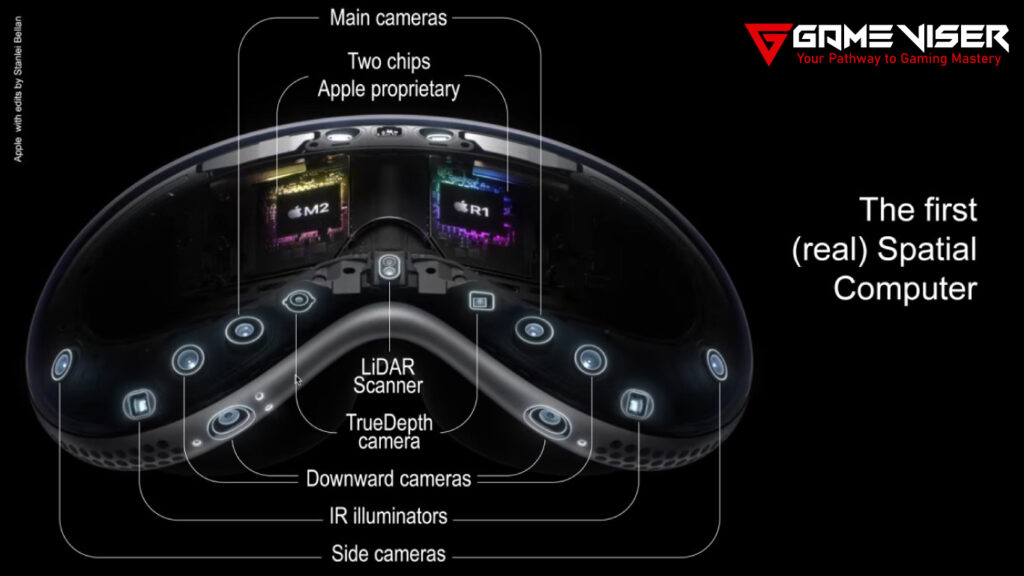
Display Properties
The Apple Vision Pro comes equipped with dual 4K micro-OLED displays that deliver over 23 million pixels combined, ensuring razor-sharp visuals with deep blacks and vibrant colors. Whether you are viewing a digital screen in AR mode or exploring a VR world, the clarity and realism are unparalleled. The field of view is wide enough to keep users deeply immersed, while the higher refresh rate eliminates motion blur and latency as well.
Performance Details
The Apple Vision Pro delivers unmatched and unparalleled performance thanks to the support of the M2 chip. This is a custom processor made by Apple, specifically designed for mixed reality. The M2 chip is highly regarded for its efficiency and performance in Apple’s laptops and tablets. It is coupled with the R1 co-processor, which handles real-time processing of data from the device’s numerous sensors.
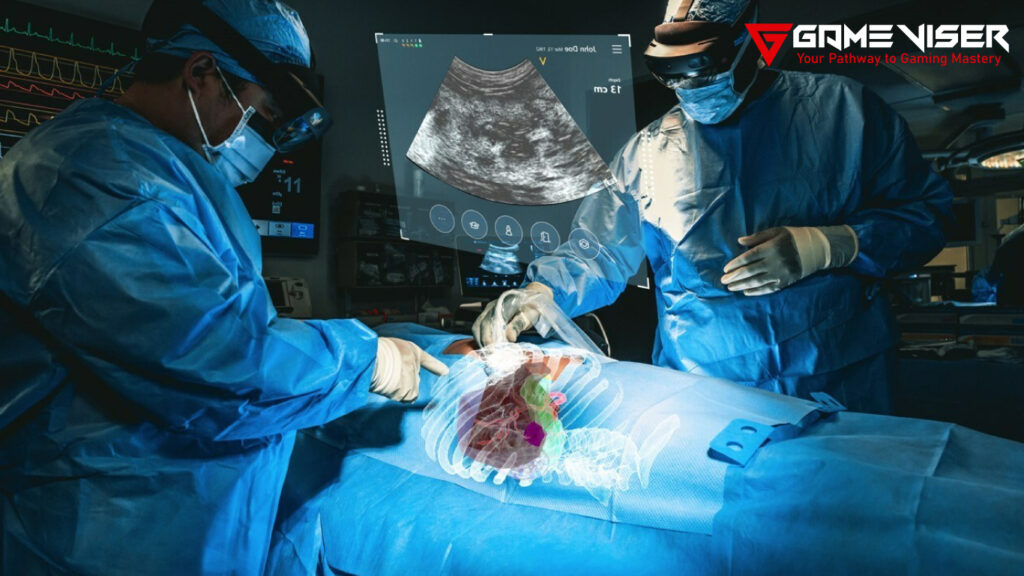
The M2 handles the computing tasks, while the R1 chip processes inputs from 12 cameras, five sensors, and six microphones in real time, ensuring that everything you see appears instantly before your eyes. This dual-chip architecture ensures that the Vision Pro runs smoothly, providing high-quality visuals and responsive performance without overheating or lag. In both AR and VR activities and games, the device runs smoothly and handles them effortlessly to provide a lag-free experience.
OS & Softwares
Apple has introduced a new operating system for the Vision Pro called VisionOS. It is built on the foundation of iOS but is highly optimized for mixed reality and spatial computing. The interface is unique, allowing users to interact with digital elements through eye movement, hand gestures, and voice commands. Apple has also extended support for popular apps like FaceTime, Safari, and Messages, which have been redesigned for mixed reality. Developers are provided with SDKs to create custom apps that enhance the capabilities of the Vision Pro.
| Property | Description |
|---|---|
| Operating System | visionOS |
| User Interface | 3D interface that allows apps to be arranged in the space around the user, creating a spatial computing experience. |
| Input Methods | Controlled by eyes, hands, and voice for seamless interaction. |
| Integration | Works with other Apple devices like Mac, enabling a large virtual display. |
| Display | Supports spatial computing with high-resolution, immersive visuals. |
| Application Support | Compatible with various apps for entertainment, productivity, and creative work. |
| App Management | Apps can be resized, moved, and arranged freely within your environment. |
| Performance | Powered by the M2 chip and R1 chip for real-time responsiveness and smooth interactions. |
| Security Features | Includes Optic ID for iris-based authentication; data is encrypted and processed within the Secure Enclave. |
| Audio Integration | Spatial audio with dynamic head tracking for an immersive sound experience. |
| Accessibility | Built-in accessibility features like VoiceOver, Zoom, and Voice Control for enhanced usability for all users. |
| App Store | Dedicated App Store for visionOS apps specifically designed for the spatial computing experience. |
| Environmental Adaptation | Uses advanced sensors to adapt digital content to the user’s real-world surroundings. |
Eye Tracking & Hand Gestures
One of the standout features of the Apple Vision Pro is its advanced eye-tracking technology. It uses infrared cameras and machine learning algorithms to accurately detect where the user is looking. Complementing this is the hand gesture recognition system, which lets users interact with digital objects by reaching out and grabbing them, pinching to select, or swiping to scroll. In short, users can simply look at an app to select it, tap their fingers to interact, or speak a command to execute tasks. This combination of eye tracking and gesture control removes the need for traditional controllers and makes the experience more natural and futuristic.
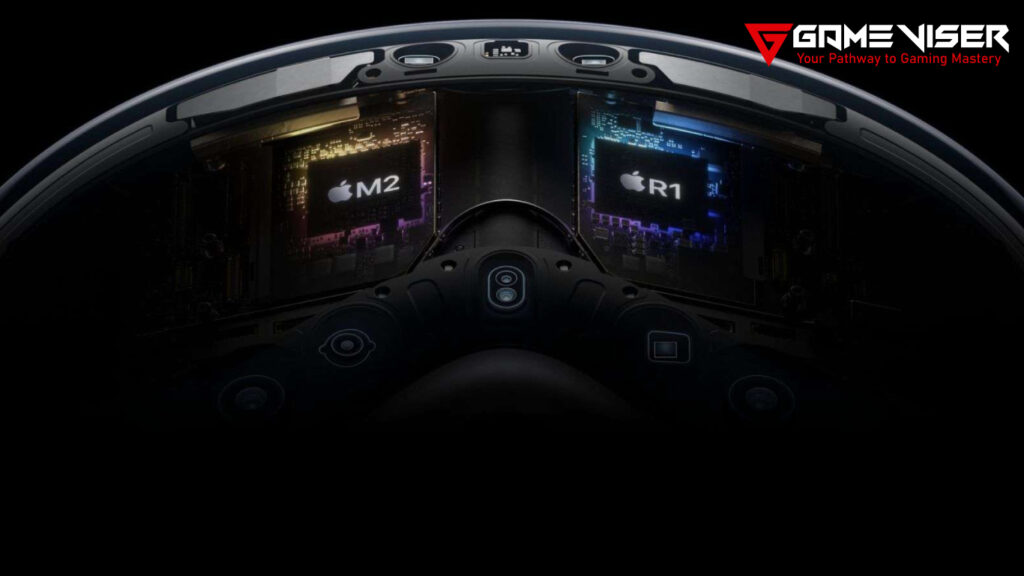
Privacy & Security
Privacy has always been a core principle in Apple’s products. The device uses a new Optic ID system, an iris-based authentication method that ensures only you can access your content. Optic ID data is fully encrypted and stored securely within the device. This high level of security extends to other interactions as well, ensuring your personal data remains safe. The Apple Vision Pro employs end-to-end encryption for all communications and ensures that data such as eye-tracking and hand-gesture inputs are processed locally and never leave the device. VisionOS also includes on-device processing for most tasks. Additionally, the device features an opt-in mechanism for sharing personal data with apps and gives users full control over the information they share.
Battery & Charging
One area where mixed reality headsets often fall short is battery life. But Apple is determined to address this with the Vision Pro. The device is powered by a swappable battery pack that offers up to 2 hours of usage on a single charge. The device also features direct power source connectivity, allowing users to use it for longer sessions.
Price and Availability
The Apple Vision Pro is available at a premium price, starting at $3,499. The device is expected to be available in select regions starting in early 2025, with a gradual rollout to other markets. The Vision Pro can be purchased at Apple Stores, Amazon, and other retailers.
Conclusion
The Apple Vision Pro is a revolutionary device that could redefine how we experience the digital world. By blending the best of AR and VR with signature design and ecosystem, the Vision Pro offers a compelling glimpse into the future of mixed reality. Whether you are interested in its productivity features, entertainment options, or potential for education and healthcare, the Vision Pro is an exciting step forward in the evolution of technology.
FAQs
What is Apple Vision Pro used for?
The Apple Vision Pro is used for mixed reality experiences, integrating augmented and virtual reality for immersive applications.
Is the Apple Vision Pro selling well?
Sales data is not fully available yet, but initial reports suggest strong interest and positive reception.
What is the price of Apple Vision Pro?
As of the latest information, the Apple Vision Pro is priced at $3,499 in the United States.
What countries is Apple Vision Pro available in?
The Apple Vision Pro is available in select countries, including the United States and Canada, with plans to expand to other regions.
Is the Vision Pro flopping?
There is no evidence to suggest that the Vision Pro is flopping; it is generating significant interest and positive reviews.

